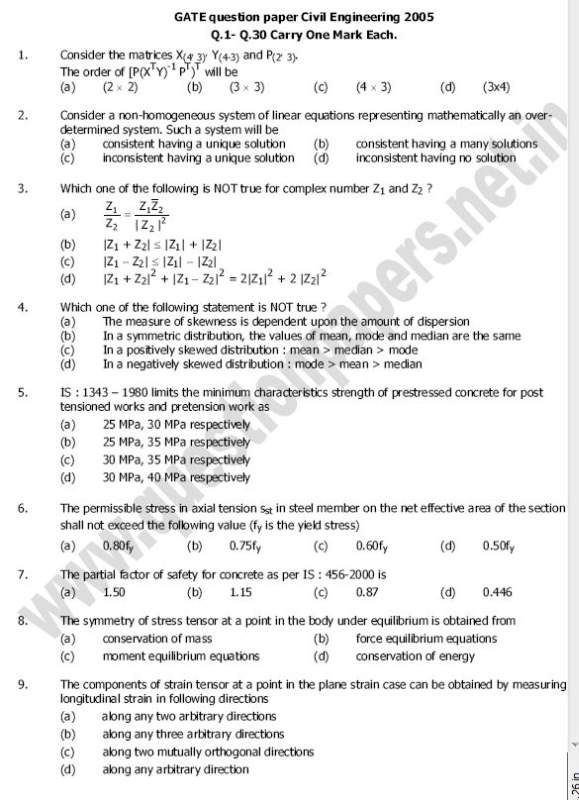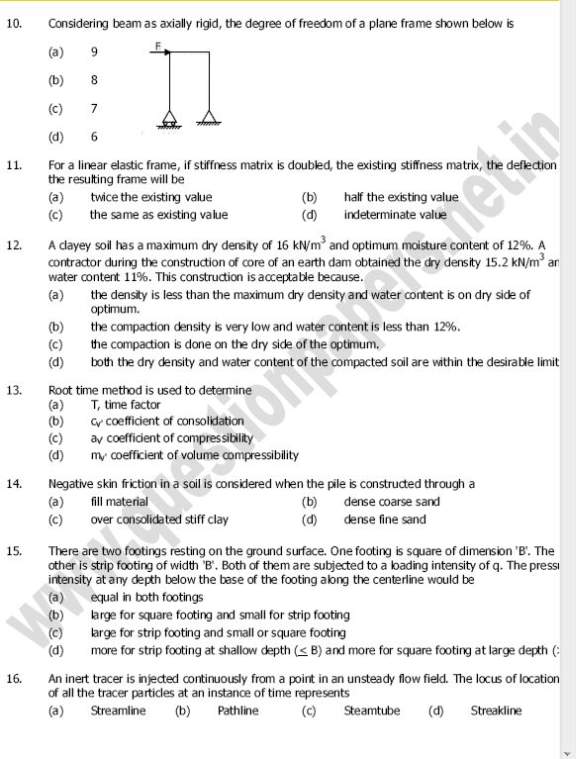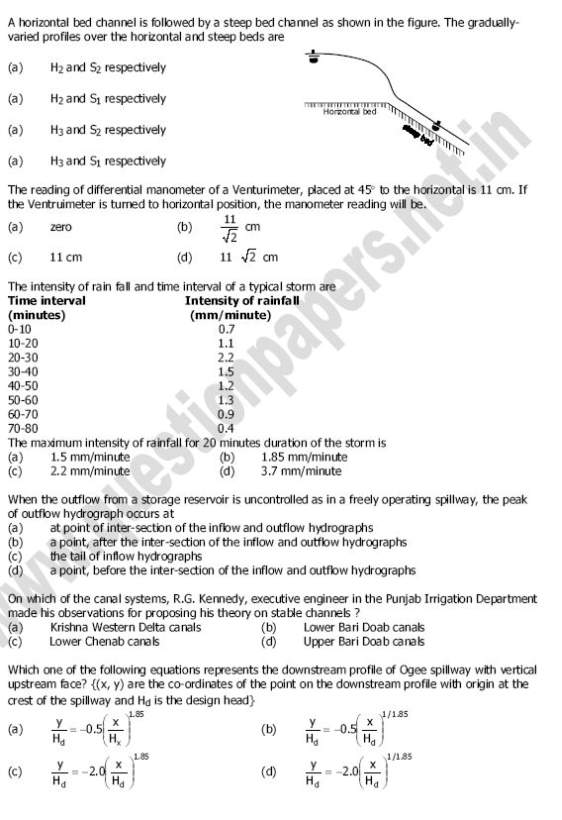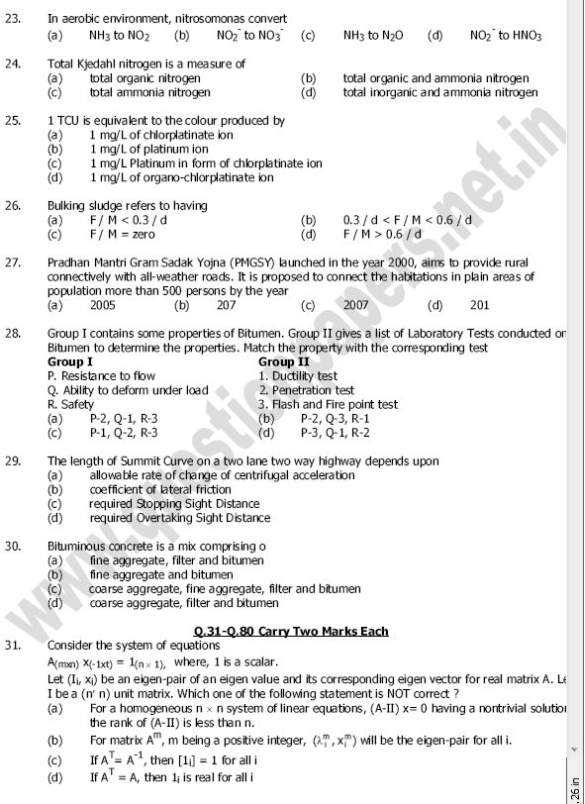| Re: Last years paper for GATE Civil Engg
Graduate Aptitude Test in Engineering (GATE) is an all India competitive examination conducted by the GATE Committee comprising of Faculty members from IISc, Bangalore and other seven IIT’s on behalf of the National Coordinating Board, Department of Education, Ministry of Human Resources Development.
Here is the GATE CE Syllabus:
Linear Algebra: Matrix algebra, Systems of linear equations, Eigen values and eigenvectors.
Calculus: Functions of single variable, Limit, continuity and differentiability, Mean value theorems, Evaluation of definite and improper integrals, Partial derivatives, Total derivative, Maxima and minima, Gradient, Divergence and Curl, Vector identities, Directional derivatives, Line, Surface and Volume integrals, Stokes, Gauss and Green's theorems.
Differential equations: First order equations (linear and nonlinear), Higher order linear differential equations with constant coefficients, Cauchy's and Euler's equations, Initial and boundary value problems, Laplace transforms, Solutions of one dimensional heat and wave equations and Laplace equation.
Complex variables: Analytic functions, Cauchy's integral theorem, Taylor and Laurent series.
Probability and Statistics: Definitions of probability and sampling theorems, Conditional probability, Mean, median, mode and standard deviation, Random variables, Poisson, Normal and Binomial distributions.
Numerical Methods: Numerical solutions of linear and non-linear algebraic equations Integration by trapezoidal and Simpson's rule, single and multi-step methods for differential equations.
GENERAL APTITUDE(GA):
Verbal Ability: English grammar, sentence completion, verbal analogies, word groups, instructions, critical reasoning and verbal deduction.
Structural Engineering
Mechanics: Bending moment and shear force in statically determinate beams. Simple stress and strain relationship: Stress and strain in two dimensions, principal stresses, stress transformation, Mohr's circle. Simple bending theory, flexural and shear stresses, unsymmetrical bending, shear centre. Thin walled pressure vessels, uniform torsion, buckling of column, combined and direct bending stresses.
Structural Analysis: Analysis of statically determinate trusses, arches, beams, cables and frames, displacements in statically determinate structures and analysis of statically indeterminate structures by force/ energy methods, analysis by displacement methods (slope deflection and moment distribution methods), influence lines for determinate and indeterminate structures. Basic concepts of matrix methods of structural analysis.
Concrete Structures: Concrete Technology- properties of concrete, basics of mix design. Concrete design- basic working stress and limit state design concepts, analysis of ultimate load capacity and design of members subjected to flexure, shear, compression and torsion by limit state methods. Basic elements of prestressed concrete, analysis of beam sections at transfer and service loads.
Steel Structures: Analysis and design of tension and compression members, beams and beam- columns, column bases. Connections- simple and eccentric, beam'column connections, plate girders and trusses. Plastic analysis of beams and frames.
Geotechnical Engineering
Soil Mechanics: Origin of soils, soil classification, three-phase system, fundamental definitions, relationship and interrelationships, permeability & seepage, effective stress principle, consolidation, compaction, shear strength.
Foundation Engineering: Sub-surface investigations- scope, drilling bore holes, sampling, penetration tests, plate load test. Earth pressure theories, effect of water table, layered soils. Stability of slopes-infinite slopes, finite slopes. Foundation types-foundation design requirements. Shallow foundations-bearing capacity, effect of shape, water table and other factors, stress distribution, settlement analysis in sands & clays. Deep foundations pile types, dynamic & static formulae, load capacity of piles in sands & clays, negative skin friction.
Water Resources Engineering
Fluid Mechanics and Hydraulics: Properties of fluids, principle of conservation of mass, momentum, energy and corresponding equations, potential flow, applications of momentum and Bernoulli's equation, laminar and turbulent flow, flow in pipes, pipe networks. Concept of boundary layer and its growth. Uniform flow, critical flow and gradually varied flow in channels, specific energy concept, hydraulic jump. Forces on immersed bodies, flow measurements in channels, tanks and pipes. Dimensional analysis and hydraulic modeling. Kinematics of flow, velocity triangles and specific speed of pumps and turbines.
Hydrology: Hydrologic cycle, rainfall, evaporation, infiltration, stage discharge relationships, unit hydrographs, flood estimation, reservoir capacity, reservoir and channel routing. Well hydraulics.
Irrigation: Duty, delta, estimation of evapo-transpiration. Crop water requirements. Design of: lined and unlined canals, waterways, head works, gravity dams and spillways. Design of weirs on permeable foundation. Types of irrigation system, irrigation methods. Water logging and drainage, sodic soils.
Environmental Engineering
Water requirements: Quality standards, basic unit processes and operations for water treatment. Drinking water standards, water requirements, basic unit operations and unit processes for surface water treatment, distribution of water. Sewage and sewerage treatment, quantity and characteristics of wastewater. Primary, secondary and tertiary treatment of wastewater, sludge disposal, effluent discharge standards. Domestic wastewater treatment, quantity of characteristics of domestic wastewater, primary and secondary treatment Unit operations and unit processes of domestic wastewater, sludge disposal.
Air Pollution: Types of pollutants, their sources and impacts, air pollution meteorology, air pollution control, air quality standards and limits.
Municipal Solid Wastes: Characteristics, generation, collection and transportation of solid wastes, engineered systems for solid waste management (reuse/ recycle, energy recovery, treatment and disposal).
Noise Pollution: Impacts of noise, permissible limits of noise pollution, measurement of noise and control of noise pollution.
Transportation Engineering
Highway Planning: Geometric design of highways, testing and specifications of paving materials, design of flexible and rigid pavements
Traffic Engineering: Traffic characteristics, theory of traffic flow, intersection design, traffic signs and signal design, highway capacity.
Surveying
Importance of surveying, principles and classifications, mapping concepts, coordinate system, map projections, measurements of distance and directions, leveling, theodolite traversing, plane table surveying, errors and adjustments, curves
Question paper:
1. A square matrix B is skew symmetric if
(A) BT = B (B) BT = B (C) B1 = B (D) B1 = BT
2. For a scalar function f(x, y, z) = x2 + 3x2, the gradient at the point P (1, 2, 1) is
(A) k 4 j 6 i 2
(B) k 4 j 12 i 2
(C) k 4 j 12 i 2
(D) 56
3. The analytic function f(z) =
1 z
1 z
2
has singularities at
(A) 1 and 1 (B) 1 and i (C) 1 and i (D) i and i
4. A thin walled cylindrical pressure vessel having a radius of 0.5m and wall thickness of 25mm is
subjected to an internal pressure of 700kPa. The hoop stress developed is
(A) 14MPa (B) 1.4MPa (C) 0.14MPa (D) 0.014MPa
5. The modulus of rupture of concrete in terms of its characteristic cube compressive strength (fck) in
MPa according to IS 456:2000 is
(A) 5000fck (B) 0.7fck (C) 5000 ck f (D) 0.7 ck f
6. In the theory of plastic bending of beams, the ratio of plastic moment to yield moment is called
(A) Shape factor (B) Plastic section modulus
(C) Modulus of resilience (D) Rigidity modulus
7. For limit state of collapse, the partial safety factors recommended by IS 456:2000 for estimating the
design strength of concrete and reinforcing steel are respectively
(A) 1.15 and 1.5 (B) 1.0 and 1.0 (C) 1.5 and 1.15 (D) 1.5 and 1.0
8. The point within the cross sectional plane of a beam through which the resultant of the external
loading on the beam has to pass through to ensure pure bending without twisting of the cross-section
of the beam is called
(A) Moment centre (B) Centroid
(C) Shear centre (D) Elastic centre
9. The square root of the ratio of moment of inertia of the cross section to its cross sectional area is
called
(A) Second moment of area (B) Slenderness ratio
(C) Section modulus (D) Radius of gyration
10. Deposit with flocculated structure is formed when
(A) Clay particles settle on sea bed
(B) Clay particles settle on fresh water lake bed
(C) Sand particles settle on river bed
(D) Sand particles settle on sea bed
GATE CIVIL ENGINEERING 2009 (CE)
11. Dilatancy correction is required when a strata is
(A) Cohesive and saturated and also has N Value of SPT > 15
(B) Saturated silt/fine sand and N value of SPT < 10 after the overburden correction
(C) Saturated silt/fine sand and N value of SPT >15 after the overburden correction
(D) Coarse sand under dry condition and N value of SPT < 10 after the overburden correction
12. A precast concrete pile is driven with a 50kN hammer falling through a height of 1.0m with an
efficiency of 0.6. The set value observed is 4mm per blow and the combined temporary compression
of the pile, cushion and the ground is 6mm. As per Modified Hiley Formula, the ultimate resistance of
the pile is
(A) 3000kN (B) 4285.7kN (C) 8.333kN (D) 11905kN
13. Direct step method of computation for gradually varied flow is
(A) Applicable to non-prismatic channels
(B) Applicable to prismatic channels
(C) Applicable to both prismatic and non-prismatic channels
(D) Not applicable to both prismatic and non-prismatic channels
14. The relationship among specific yield (Sy), specific retention (Sr) and porosity (h) of an aquifer is
(A) Sy = Sr + (B) Sy = Sr −
(C) Sy = − Sr (D) Sy = Sr + 2
15. The depth of flow in an alluvial channel is 1.5m. If critical velocity ratio is 1.1 and Manning’s n is
0.018, the critical velocity of the channel as per Kennedy’s method is
(A) 0.713m/s (B) 0.784m/s (C) 0.879m/s (D) 1.108m/s
16. The reference pressure used I the determination of sound pressure level is
(A) 20μPa (B) 20db (C) 10μPa (D) 10db
17. Particulate matter (fly ash) carried in effluent gases from the furnaces burning fossil fuels are better
removed by
(A) Cotton bag house filter (B) Electrostatic precipitator (ESP)
(C) Cyclone (D) Wet scrubber
18. The value of lateral friction or side friction used in the design of horizontal curve as per India Roads
Congress guidelines is
(A) 0.40 (B) 0.35 (C) 0.24 (D) 0.15
19. During a CBR test, the load sustained by a remolded soil specimen at 5.0mm penetration is 50kg. The
CBR value of the soil will be
(A) 10.0% (B) 5.0% (C) 3.6% (D) 2.4%
20. In quadrantal bearing system, bearing of a line varies from
(A) 0º to 360º (B) 0º to 180º (C) 0º to 90º (D) 0º N to 90ºs
Here is the attachment for GATE CE Question paper:
|



